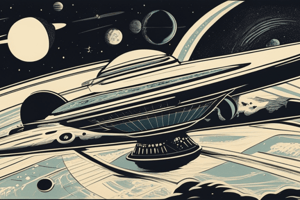Podcast
Questions and Answers
The sun is the center of our solar system
The sun is the center of our solar system
- Best (correct)
- TS
- TG
- I
The solar system is vast and contains many celestial bodies.
The solar system is vast and contains many celestial bodies.
- Best
- TS (correct)
- TG
- I
Space is interesting.
Space is interesting.
- Best
- TG (correct)
- TS
- I
The sun is hot.
The sun is hot.
The ethical implications of manipulating the human genome raise complex questions about the future of biotechnology.
The ethical implications of manipulating the human genome raise complex questions about the future of biotechnology.
Genetic engineering has both benefits and risks.
Genetic engineering has both benefits and risks.
CRISPR technology, a revolutionary gene-editing tool, allows precise modification of DNA sequences in living organisms
CRISPR technology, a revolutionary gene-editing tool, allows precise modification of DNA sequences in living organisms
Genetics is a scientific field.
Genetics is a scientific field.
Flashcards are hidden until you start studying
Study Notes
Exploring Our Cosmic Neighborhood: The Solar System
The solar system, the realm we call home, is a breathtaking collection of celestial bodies that revolve around our local sun, the life-giving star we know as Jupiter's Big Brother. This vast, intricately connected neighborhood spans billions of kilometers, each of its constituents a marvel in its own right.
Our Star: The Sun
At the heart of our solar system lies the Sun — a ball of plasma burning hydrogen into helium, its fiery embrace generating an astonishing 384.6 trillion watts of power. This blazing fireball is more than just a large, shining ball in the sky. It's the source of our planet's heat and light, a stable beacon around which we orbit.
The Inner Planets
The inner solar system, which extends from the Sun out to an average distance of about 1.5 billion kilometers, consists of the four terrestrial planets. Mercury, our smallest and closest planet, is named after the quick-footed Roman messenger god. Venus, our second inner planet, is often (and misleadingly) referred to as Earth's sister because of its similar size and composition. However, Venus' scorching surface temperatures and thick, enshrouding atmosphere belie its Earth-like appearance.
Earth, the third planet from the Sun, is undeniably our home. It's the only place we know of where life exists, and it's the only planet with liquid water on its surface. Mars, the fourth and farthest inner planet, is often called the "Red Planet" due to its rusty-red color. Its ancient dry riverbeds and craggy terrain hint at a past when Mars may have been more Earth-like.
The Asteroid Belt
The asteroid belt, a vast area between Mars and Jupiter, contains millions of rocky debris left over from the solar system's formation. This vast, empty space is dotted with countless asteroids and other space debris, some of which are large enough to be classified as dwarf planets.
The Outer Planets
The outer solar system extends from Jupiter, the first of the four gas giants, out to Neptune, the last of these giant planets. Jupiter, the largest planet in our solar system, is named after the Roman king of the gods. Its massive, gaseous body is composed primarily of hydrogen and helium, and it's the only planet in our solar system with a discernible banded structure.
Saturn, the second gas giant, is renowned for its iconic, sprawling rings. These rings are made of millions of particles of ice, dust, and other small objects. We're still unsure of Saturn's origin, but these rings are thought to be remnants of a past moonlet, now shattered and scattered through space.
Uranus, the third gas giant, is named after the Greek god of the sky. It has a blue-green hue that is the result of methane in its atmosphere. Uranus is unique in that it tilts on its axis, causing its seasons to be very different from those of Earth.
Neptune, the fourth and final gas giant, was the last planet discovered, in 1846. Neptune, like Uranus, has a blue-green tint due to methane in its atmosphere. It's the coldest planet in our solar system and is known for its powerful winds and storms.
The Kuiper Belt and Oort Cloud
Beyond Neptune lies the icy Kuiper Belt, a vast, sparsely populated region of our solar system that contains countless small bodies, including dwarf planets and other space debris. Many astronomers believe that the Kuiper Belt is a remnant of the solar system's formation, a leftover from the birth of our solar system.
The Oort Cloud, at the outermost edge of our solar system, is an incredibly vast, sparse region that contains trillions of comets. The Oort Cloud is believed to be a reservoir of comets, and it's believed that the gravitational influence of passing stars can disturb this region, sending comets into the inner solar system and potentially crossing paths with Earth.
The solar system, our celestial neighborhood, is an ever-expanding field of study filled with wonders and mysteries yet to be revealed. Each of these celestial bodies, from our fiery Sun to the distant Oort Cloud, holds a unique tale of the solar system's formation and evolution. Understanding the solar system means understanding our place in the cosmos, and it's a journey of learning and discovery that continues to captivate us each and every day.
Studying That Suits You
Use AI to generate personalized quizzes and flashcards to suit your learning preferences.




